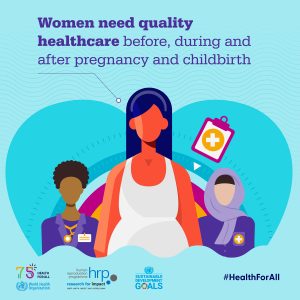
Monday was World Health Day – an annual global event which provides an opportunity to highlight pressing health issues affecting communities worldwide. This year’s theme, Healthy Beginnings, Hopeful Futures, underscores the importance of supporting maternal and newborn health.
Alcohol policies have a key role in supporting maternal and fetal health by influencing the environment in which decisions about alcohol use are made. Supportive alcohol policies a part of comprehensive and multi-sectoral efforts to prevent Fetal Alcohol Spectrum Disorder (FASD).
The role of alcohol policy
In Canada, our model of FASD prevention includes four mutually reinforcing levels. Alcohol policies that are supportive of maternal and fetal health are in the centre of the model, influencing each level in important ways. Here’s what alcohol policy can look like at the different levels:
- Level 1 prevention – Broad awareness raising and health promotion: Warning labels and point-of-sale warnings can help raise awareness of the harms of alcohol use in pregnancy and where to received more information and support. They have been shown to reduce alcohol use in pregnancy, especially when paired with multi-level community-driven alcohol strategies.
- Level 2 prevention – Discussion of alcohol use and related risks: National uptake of alcohol guidelines, including Canada’s Guidance on Alcohol and Health, can improve clarity and messages about the risks of alcohol use. Consistent and clear messages should be paired with universal compassionate alcohol brief interventions and screening that seek to understand the influences on alcohol use in pregnancy and preferences for support.
- Level 3 and Level 4 preventions – Support during pregnancy and postpartum: Cross-sectoral collaboration and multi-pronged policies that respond to the factors that contribute to alcohol use in pregnancy are key for fostering healthy pregnancies and beginnings.
Learn more
World Health Day marked the launch of the World Health Organization’s year long campaign on Healthy Beginnings, Hopeful Futures, offering an opportunity to learn more about how alcohol policies can support healthy pregnancies. The following resources provide more information on applying supportive alcohol policies at the community, provincial, and national levels:
- Alcohol Policy and FASD webinar series
- Supportive alcohol policy as a key element of FASD prevention article
- The Prevention Conversation online training program
Hopeful futures
By expanding the focus of alcohol policy, we can take meaningful steps toward a future where every woman is supported throughout her pregnancy and every child has the best possible start in life. World Health Day serves as a reminder that real change happens when we address the root causes of health disparities – including the policies that shape our drinking environments.